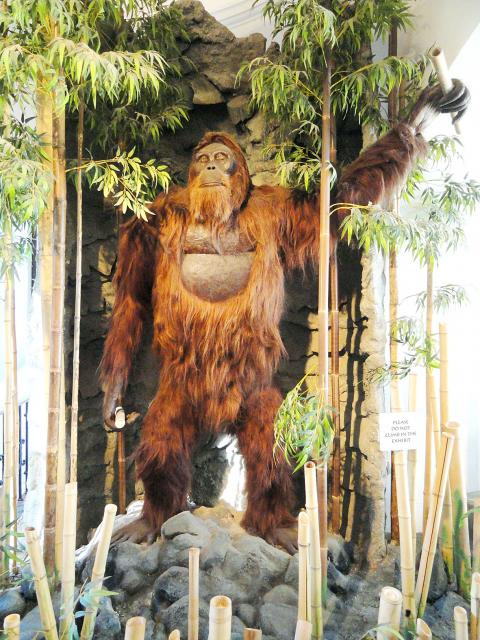The largest ape to roam Earth died out 100,000 years ago because it failed to tuck into savannah grass after climate change hit its preferred diet of forest fruit, scientists suggest.
Gigantopithecus — the closest Nature ever came to producing a real King Kong — weighed five times as much as an adult man and probably stood 3m tall, according to sketchy estimates.
In its heyday a million years ago, it inhabited semi-tropical forests in southern China and mainland Southeast Asia.

Photo courtesy of Wikimedia Commons
Until now, though, almost nothing was known about the giant’s anatomical shape or habits. The only fossil records are four partial lower jaws, and perhaps a thousand teeth — the first of which turned up in the 1930s in Hong Kong apothecaries where they were sold as “dragon’s teeth.”
These meagre remains “are clearly insufficient to say if the animal was bipedal or quadrupedal, and what would be its body proportions,” Herve Bocherens, a researcher at T|bingen University in Germany, says.
Its closest modern cousin is the orangutan, but whether Gigantopithecus had the same golden-red hue, or was black like a gorilla is unknown. Another mystery: its diet. Was it a meat-eater or a vegetarian? Did it share a taste for bamboo with its neighbour the prehistoric giant panda?

Photo courtesy of Wikimedia Commons
Answering this riddle might also tell us why a monster that surely had little to fear from other fauna went extinct.
ADAPT OR DIE
That’s where the teeth had a story to tell.
Examining slight variations in carbon isotopes found in tooth enamel, Bocherens and an international team of scientists showed that the primordial King Kong lived only in the forest, was a strict vegetarian, and probably wasn’t crazy about bamboo.
These narrow preferences did not pose a problem for Gigantopithecus until Earth was struck by a massive ice age during the Pleistocene Epoch, which stretched from about 2.6 million to 12,000 years ago.
That’s when nature, evolution — and perhaps a refusal to try new foods — conspired to doom the giant ape, Bocherens explained.
“Due to its size, Gigantopithecus presumably depended on a large amount of food,” he said.
“When during the Pleistocene, more and more forested area turned into savannah landscapes, there was simply an insufficient food supply.”
And yet, according to the study, other apes and early humans in Africa that had comparable dental gear were able to survive similar transitions by eating the leaves, grass and roots offered by their new environments. But for some reason, Asia’s giant ape — which was probably too heavy to climb trees, or swing in their branches — did not make the switch.
“Gigantopithecus probably did not have the same ecological flexibility and possibly lacked the physiological ability to resist stress and food shortage,” notes the study, which is to be published in a specialist journal, Quaternary International. Whether the mega-ape could have adapted to a changing world but didn’t, or whether it was doomed by climate and its genes, is probably one mystery that will never be solved. Climate change several hundred thousand years ago was also likely responsible for the disappearance of many other large animals from the Asian continent.

“Why does Taiwan identity decline?”a group of researchers lead by University of Nevada political scientist Austin Wang (王宏恩) asked in a recent paper. After all, it is not difficult to explain the rise in Taiwanese identity after the early 1990s. But no model predicted its decline during the 2016-2018 period, they say. After testing various alternative explanations, Wang et al argue that the fall-off in Taiwanese identity during that period is related to voter hedging based on the performance of the Democratic Progressive Party (DPP). Since the DPP is perceived as the guardian of Taiwan identity, when it performs well,

The Taiwan People’s Party (TPP) on May 18 held a rally in Taichung to mark the anniversary of President William Lai’s (賴清德) inauguration on May 20. The title of the rally could be loosely translated to “May 18 recall fraudulent goods” (518退貨ㄌㄨㄚˋ!). Unlike in English, where the terms are the same, “recall” (退貨) in this context refers to product recalls due to damaged, defective or fraudulent merchandise, not the political recalls (罷免) currently dominating the headlines. I attended the rally to determine if the impression was correct that the TPP under party Chairman Huang Kuo-Chang (黃國昌) had little of a

At Computex 2025, Nvidia CEO Jensen Huang (黃仁勳) urged the government to subsidize AI. “All schools in Taiwan must integrate AI into their curricula,” he declared. A few months earlier, he said, “If I were a student today, I’d immediately start using tools like ChatGPT, Gemini Pro and Grok to learn, write and accelerate my thinking.” Huang sees the AI-bullet train leaving the station. And as one of its drivers, he’s worried about youth not getting on board — bad for their careers, and bad for his workforce. As a semiconductor supply-chain powerhouse and AI hub wannabe, Taiwan is seeing

Jade Mountain (玉山) — Taiwan’s highest peak — is the ultimate goal for those attempting a through-hike of the Mountains to Sea National Greenway (山海圳國家綠道), and that’s precisely where we’re headed in this final installment of a quartet of articles covering the Greenway. Picking up the trail at the Tsou tribal villages of Dabang and Tefuye, it’s worth stocking up on provisions before setting off, since — aside from the scant offerings available on the mountain’s Dongpu Lodge (東埔山莊) and Paiyun Lodge’s (排雲山莊) meal service — there’s nowhere to get food from here on out. TEFUYE HISTORIC TRAIL The journey recommences with